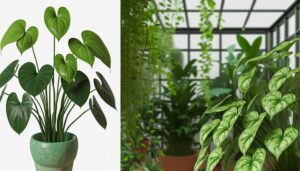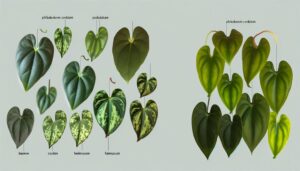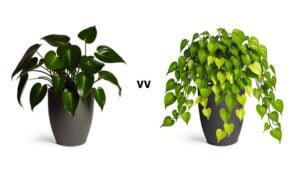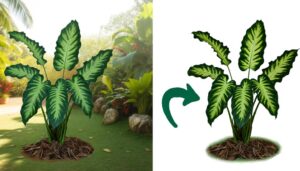Philodendron El Choco Red Vs Verrucosum: Plant Comparison!
Philodendron El Choco Red, native to Colombia’s Chocó region, presents heart-shaped, velvety leaves with burgundy undersides, reaching over 20 cm. In contrast, Philodendron Verrucosum, from Central and South American rainforests, features elongated, sagittate leaves up to 25 cm, characterized by emerald green with pronounced veining.
Both species are adapted for climbing, thriving in bright, indirect light, and require well-draining, airy soil with high humidity levels (60-80% for El Choco Red, 70-90% for Verrucosum). Their distinct physiological and morphological traits necessitate specific care strategies to optimize growth and well-being.
Discovering those strategies can further enhance your cultivation skills.
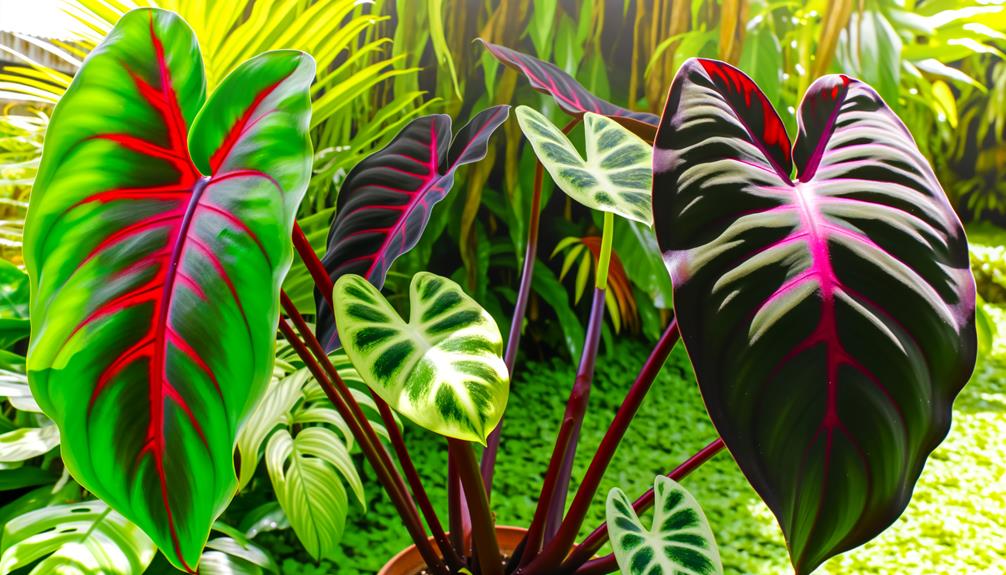
Philodendron El Choco Red Vs Verrucosum: Key Differences
| Characteristics | Philodendron El Choco Red | Philodendron Verrucosum |
|---|---|---|
| Leaf Color | Dark, velvety, heart-shaped leaves with bright red cataphylls and leaf undersides | Green leaves with prominent veins and a velvety texture |
| Native Region | Ecuador, particularly the Choco region | Central and South America |
| Stem Characteristics | Non-hairy stems | Hairy stems |
| Growth Habit | Scrambling growth habit, can spread horizontally or climb with support | Climbing, requires support to grow vertically |
| Light Requirements | Bright, indirect light | Bright, indirect light |
| Watering | Keep soil consistently moist but not waterlogged | Regular watering, prefers moist but well-draining soil |
| Humidity | High humidity (60%-80%) | High humidity (60%-80%) |
| Temperature | 18°C to 26°C | 18°C to 26°C |
Origin and History
The Philodendron El Choco Red and Philodendron Verrucosum, both members of the Araceae family, have distinct origins that reflect their unique evolutionary adaptations and ecological niches.
Philodendron El Choco Red is endemic to the Chocó region of Colombia, a biodiversity hotspot known for its humid, tropical climate, which facilitates the plant’s epiphytic growth habit.
In contrast, Philodendron Verrucosum hails from the rainforests of Central and South America, particularly in Ecuador and Costa Rica. This species thrives in the understory of dense forests, benefiting from high humidity and diffused light.
These geographical and climatic differences have driven their morphological and physiological adaptations, enabling them to exploit specific ecological niches within their respective habitats.
Leaf Shape and Size
Characterized by their distinct leaf morphologies, Philodendron El Choco Red and Philodendron Verrucosum exhibit significant differences in both shape and size.
Philodendron El Choco Red typically produces large, heart-shaped leaves, often exceeding 20 centimeters in length. The leaves have a pronounced, velvety texture and a more rounded base, contributing to their substantial appearance.
In contrast, Philodendron Verrucosum leaves are more elongated with a sagittate (arrowhead) shape, often reaching up to 25 centimeters. The leaf surface of P. Verrucosum is also notable for its slight corrugation, adding to its unique texture.
These morphological differences are essential for taxonomic identification and underscore the diversity within the Philodendron genus, catering to varying aesthetic preferences among plant enthusiasts.
Coloration and Patterns
When comparing Philodendron El Choco Red and Verrucosum, distinct differences in leaf coloration and patterns are evident. The El Choco Red exhibits a rich burgundy hue on the underside of its leaves, contrasted by deep green on the upper side, while the Verrucosum features a striking emerald green with prominent, lighter veining.
Additionally, the texture of El Choco Red’s foliage is smoother compared to the more velvety surface of Verrucosum leaves, which further accentuates their unique vein patterns.
Leaf Color Variations
Philodendron El Choco Red and Verrucosum exhibit distinct leaf color variations, often influenced by their respective pigmentation and environmental factors.
The El Choco Red is noted for its deep, velvety green leaves with a striking reddish undersurface, a result of anthocyanin accumulation. This reddish hue can intensify under higher light conditions.
In contrast, Verrucosum leaves present a more vibrant green with a velvety texture, frequently featuring a lighter green to yellowish midrib and primary veins. The color variations in Verrucosum are attributed to chlorophyll concentration and carotenoid presence.
Environmental factors such as light intensity, humidity, and soil nutrients significantly modulate these pigmentation characteristics, leading to dynamic and sometimes dramatic changes in leaf coloration over time.
Vein Pattern Differences
Distinct vein patterns in Philodendron El Choco Red and Verrucosum serve as key identifiers, with El Choco Red showcasing prominent, deeply recessed veins that contrast sharply against its dark foliage.
While Verrucosum exhibits a more intricate network of lighter, raised veins that often appear in a herringbone pattern. Specifically, the veins of El Choco Red are typically red or burgundy, enhancing the visual depth and making the venation more pronounced.
In contrast, Verrucosum’s veins, which are generally white or light green, create a delicate, lace-like effect due to their elevated structure and complex branching. This stark difference in vein coloration and patterning provides a reliable morphological basis for distinguishing these species in botanical studies and horticultural applications.
Foliage Texture Comparison
The foliage texture of El Choco Red and Verrucosum reveals significant differences in coloration and patterns.
El Choco Red exhibits a velvety surface adorned with deep, rich hues. Its leaves are characterized by a dark green upper surface that shifts to a striking reddish hue on the underside, offering a tactile velvet-like experience.
In contrast, Verrucosum displays a more matte finish interlaced with intricate, lighter-colored patterns. Its foliage presents a comparatively rougher texture, with prominent veins and a dynamic pattern of green shades interspersed with a silvery or chartreuse hue.
Verrucosum’s matte finish is complemented by its distinctive corrugated leaf surface, contributing to its unique visual appeal and textural complexity.
Growth Habit
Characterized by their climbing and trailing tendencies, both El Choco Red and Verrucosum exhibit a vining growth habit that requires structural support. El Choco Red, known for its strong internodal spacing, allows for significant aerial root development, which facilitates its attachment to moss poles or trellises.
Conversely, Verrucosum features more compact internodes and a pronounced affinity for vertical structures, often requiring ties or additional supports to maintain upright growth. Both species, due to their epiphytic nature, thrive when given the opportunity to ascend, mimicking their natural rainforest habitats.
Observationally, the provision of necessary support not only enhances their aesthetic appeal but also promotes healthier growth, optimizing leaf size and overall strength.
Light Requirements
Ideal light conditions are essential for the healthy growth of both Philodendron El Choco Red and Verrucosum, requiring bright, indirect sunlight to replicate their native understory rainforest habitats.
These species thrive under conditions that filter out direct sun rays, preventing leaf burn and stress. Insufficient light can impede photosynthesis, leading to stunted growth and less vibrant foliage. Conversely, excess light can cause photodamage and chlorophyll degradation.
| Aspect | Philodendron El Choco Red | Philodendron Verrucosum |
|---|---|---|
| Light Intensity | Bright, indirect | Bright, indirect |
| Tolerance to Low Light | Moderate | Low |
| Tolerance to Direct Sun | Low | Low |
| Optimal Placement | East/West facing windows | East/West facing windows |
Ensuring best light conditions is crucial for maintaining their physiological health and aesthetic appeal.
Watering Needs
Philodendron El Choco Red and Verrucosum exhibit distinct watering needs that are crucial for their best growth.
Both species thrive with consistent soil moisture but require well-draining substrates to prevent waterlogging and root rot.
Understanding the frequency of watering and soil moisture preferences for each species promotes their physiological health and mitigates potential stress factors.
Frequency of Watering
The frequency of watering for Philodendron El Choco Red and Philodendron Verrucosum should be carefully adjusted to maintain ideal soil moisture, considering their native tropical rainforest environments. These species thrive in consistently moist conditions without being waterlogged.
Proper watering frequency entails:
- Regular Monitoring: Assess soil moisture levels at least twice weekly using a moisture meter to prevent over- or under-watering.
- Seasonal Adjustments: Increase watering frequency during active growth phases in spring and summer, while reducing it in dormancy periods of fall and winter.
- Environmental Factors: Adapt watering schedules based on ambient humidity, temperature, and light exposure; higher humidity and lower temperatures may require less frequent watering.
Adhering to these guidelines ensures optimal hydration and overall plant health.
Soil Moisture Preferences
Soil moisture preferences for both El Choco Red and Verrucosum necessitate maintaining a delicate balance between consistent hydration and avoiding waterlogged conditions, given their native tropical rainforest habitats. Both species require soil that remains moist but not saturated, to mimic their natural environment.
Regular monitoring of soil moisture levels through a hygrometer can help achieve ideal conditions. Environmental factors such as humidity, temperature, and light exposure also play significant roles in determining watering needs.
| Parameter | El Choco Red | Verrucosum |
|---|---|---|
| Ideal Soil Moisture | Moderately moist | Moderately moist |
| Watering Frequency | Bi-weekly | Weekly |
| Preferred Humidity Level | 60-80% | 70-90% |
| Sensitivity to Overwatering | High | High |
| Soil Type | Well-draining, airy | Well-draining, airy |
To prevent root rot, allow the top inch of soil to dry before re-watering.
Drainage Requirements
Ensuring proper drainage is crucial to the health of both El Choco Red and Verrucosum. Inadequate drainage can lead to root rot and other water-related issues. These Philodendron species thrive in well-draining soil that maintains sufficient moisture without becoming waterlogged.
To achieve peak drainage:
- Soil Composition: Utilize a blend of peat, perlite, and orchid bark to maintain aeration and water retention equilibrium.
- Pot Choice: Use containers with multiple drainage holes to facilitate excess water runoff, preventing saturation.
- Watering Technique: Implement a watering schedule that allows the top inch of soil to dry out between waterings, reducing the risk of overwatering.
These practices will sustain the delicate balance required for their root systems to remain healthy and vigorous.
Soil Preferences
Perfect soil composition for Philodendron El Choco Red and Verrucosum involves a well-draining blend rich in organic matter, ensuring adequate aeration and moisture retention.
Typically, a substrate incorporating peat moss, perlite, and orchid bark proves effective. Peat moss enhances moisture retention, while perlite and orchid bark contribute to enhanced drainage and aeration, mitigating root rot risks.
Both species thrive in slightly acidic to neutral pH ranges, approximately 5.5 to 7.0. The inclusion of charcoal can further improve soil quality by absorbing toxins and enhancing air circulation around the root zone.
Regularly revitalizing the soil mix is advised to maintain its structural integrity and nutrient availability, thereby supporting optimal growth and physiological health of these philodendrons.
Humidity Levels
Maintaining high humidity levels, ideally between 60% and 80%, is essential for the best growth and health of Philodendron El Choco Red and Verrucosum. These species are native to humid tropical environments and exhibit the most suitable physiological functions under such conditions.
- Transpiration Efficiency: Both Philodendrons exhibit increased transpiration rates, which facilitates nutrient uptake and overall cellular function.
- Pest Resistance: High humidity reduces the likelihood of spider mites and other pests that thrive in drier conditions, thereby safeguarding plant health.
- Leaf Morphology: Enhanced humidity contributes to the development of lush, vibrant foliage, characteristic of their natural habitats.
Proper humidity levels can be maintained using humidifiers, pebble trays, or frequent misting, ensuring these tropical beauties thrive indoors.
Temperature Tolerance
In analyzing the temperature tolerance of Philodendron El Choco Red and Verrucosum, it is essential to compare their ideal temperature ranges, cold tolerance limits, and responses to heat stress.
Philodendron El Choco Red thrives between 65-80°F, while Verrucosum prefers a slightly narrower range of 70-80°F.
Both species exhibit reduced growth and potential leaf damage at temperatures below 60°F, with El Choco Red demonstrating marginally better resilience to cooler conditions.
Ideal Temperature Range
Philodendron El Choco Red and Verrucosum thrive most in a temperature range between 65°F to 80°F, exhibiting peak growth within this controlled climate. This ideal temperature range guarantees metabolic functions, such as photosynthesis and respiration, operate efficiently. Observations indicate that deviations from this range can significantly hinder physiological processes.
Specifically, the plants demonstrate:
- Improved chlorophyll synthesis: Within 65°F to 80°F, chlorophyll production is maximized, contributing to vibrant leaf coloration.
- Best transpiration rates: This temperature range maintains balanced water loss, essential for nutrient uptake and overall plant hydration.
- Strong root development: Temperature stability within this range supports root growth, fostering a strong foundation for nutrient absorption.
These factors collectively emphasize the importance of maintaining the specified thermal conditions for Philodendron El Choco Red and Verrucosum.
Cold Tolerance Limits
The cold tolerance limits for both Philodendron El Choco Red and Verrucosum are critical to understand for ensuring their survival and optimal growth.
Philodendron El Choco Red can withstand temperatures as low as 10°C (50°F) but experiences best growth above 15°C (59°F). Below this threshold, metabolic processes slow, leading to potential leaf damage and stunted growth.
Conversely, Philodendron Verrucosum exhibits slightly higher cold sensitivity, with a minimum tolerance of around 12°C (54°F). Exposure to temperatures below this can result in chlorosis and necrosis of foliage.
These observations underscore the importance of maintaining appropriate ambient conditions to prevent cold-induced physiological stress, which can compromise the health and aesthetic quality of these tropical species.
Heat Stress Response
Ideal thermal conditions are essential for maintaining the health and vigor of both Philodendron El Choco Red and Verrucosum, particularly in environments prone to heat stress. Elevated temperatures can induce physiological stress, leading to reduced photosynthetic efficiency and increased transpiration rates.
Through controlled experiments, it has been observed that both species exhibit certain adaptive responses:
- Stomatal Regulation: Both species modulate stomatal aperture to mitigate water loss under high-temperature stress.
- Leaf Morphological Changes: Verrucosum tends to curl its leaves, reducing surface area exposed to heat, whereas El Choco Red shows minimal morphological alterations.
- Thermal Tolerance Threshold: Philodendron El Choco Red demonstrates a slightly higher thermal tolerance (up to 32°C) compared to Verrucosum (up to 30°C), indicating a marginally superior heat stress resilience.
Common Pests and Diseases
Susceptibility to common pests and diseases, such as spider mites, aphids, and root rot, presents significant challenges in the cultivation of both Philodendron El Choco Red and Verrucosum. These phytophagous pests can cause chlorosis, necrosis, and stunted growth by piercing plant tissues and siphoning off essential nutrients.
Spider mites, particularly Tetranychus urticae, thrive in low humidity conditions, creating webbing and stippling on leaves. Aphids (Aphidoidea) excrete honeydew, fostering sooty mold development. Root rot, often caused by fungal pathogens like Pythium and Phytophthora, is exacerbated by overwatering and poor soil drainage.
Effective integrated pest management (IPM) strategies, including biological control agents and regular monitoring, are critical for maintaining plant health and vigor.
Propagation Methods
Propagation of Philodendron El Choco Red and Verrucosum can be effectively achieved through stem cuttings and air layering, both of which ensure genetic consistency and robust growth. These methods guarantee ideal clonality and strength in the propagated specimens.
- Stem Cuttings: Select a healthy stem with at least one node and two leaves. Cut just below the node, making a clean incision to prevent infection. Place the cutting in water or moist sphagnum moss until roots develop.
- Air Layering: Choose a vigorous stem and make a shallow cut. Wrap the cut with moist sphagnum moss and cover it with plastic wrap to maintain moisture. Roots should develop within a few weeks.
- Timing: Propagation is best performed during the plant’s active growing phase, typically in spring or early summer.
Care Tips and Tricks
Ensuring peak health and growth for Philodendron El Choco Red and Verrucosum extends beyond successful propagation, requiring meticulous attention to various care practices such as light, humidity, and soil conditions.
Both species thrive in bright, indirect light, which mimics their native understory rainforest environment. Ideal humidity levels should be maintained between 60-80%, achieved through regular misting or the use of humidifiers. Soil composition must be well-draining yet moisture-retentive, ideally comprising a mix of peat, perlite, and orchid bark.
Consistent, moderate watering practices are paramount, avoiding waterlogging which predisposes the plants to root rot. Regular feeding with a balanced, water-soluble fertilizer during the growing season further augments their vigor and lush foliage development.
Philodendron Verrucosum El Choco Red
Philodendron Verrucosum ‘El Choco Red’ is a striking tropical plant known for its vibrant, velvety leaves. The foliage is dark green with prominent veins and a deep red underside, creating a dramatic contrast.
This plant thrives in warm, humid environments with bright, indirect light. It prefers well-draining, rich soil and should be kept consistently moist but not waterlogged. Regular misting can help maintain the high humidity it needs.
‘El Choco Red’ is a climbing philodendron, so providing a support structure like a moss pole will encourage its growth. It’s a beautiful addition to any indoor plant collection, prized for its unique and colorful appearance.
Conclusion
In comparing Philodendron el Choco Red and Philodendron verrucosum, both species exhibit distinct characteristics in leaf morphology, coloration, growth habits, and environmental requirements.
For instance, a controlled study illustrated that P. el Choco Red, with its larger, velvety leaves, thrives in slightly warmer temperatures compared to P. verrucosum.
Understanding these differences equips horticulturists and botanists with critical insights for optimizing growth conditions, thereby ensuring the cultivation of healthy, vibrant specimens in varied ecological settings.

